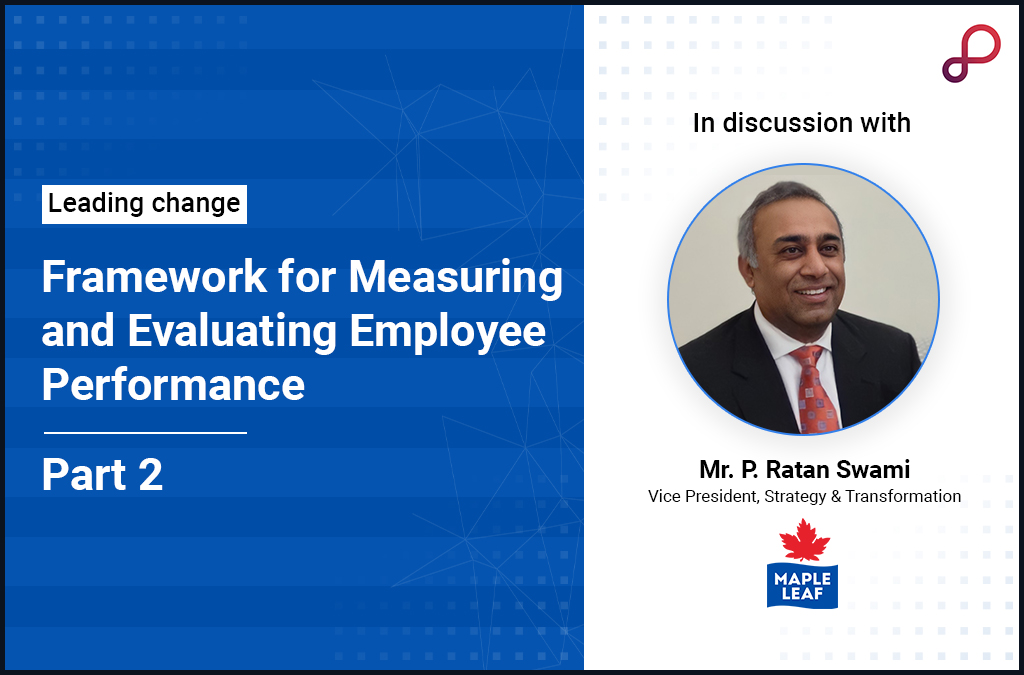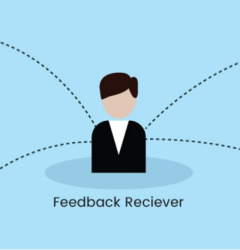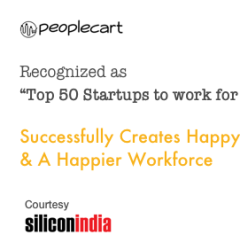30 Dec

Disclaimer: The views and opinions expressed in this article are those of the authors and do not necessarily reflect the official policy or position of his organization.
Mr. P. Ratan Swami studied at IIT, Bombay, and then at IIM Bangalore where he majored in finance and strategy. After his graduation, he worked as an investment banker for 5 years.
Then he joined Ernst & Young Consulting, on a few projects out of the Middle East and Europe. Moved to Canada in 1997 to work with Canada Bread/Maple Leaf Foods, a conglomerate in the food sector, and has worked on strategy, turnarounds, and mergers and acquisitions. The company offers a great work culture and is recognized for being one of the best employers in Canada.
Q – Don’t you think this whole process will also highlight any gaps in the skills and competencies required to do a job, not at just that level, but even at a higher level? Does that linkage with the implementation of training and development prove very important for the career growth of the employee?
That’s absolutely true. Employees look for a win-win and ask, ‘What’s in it for me?’ and do things because they see a benefit in it for them.
Q – Do you think career development is a major perk when compared to other things that organizations offer to employees? If an organization makes its employees’ career development the main offering from their side to the employees, they may find it far more attractive than any monetary benefits.
To some extent, yes. There’s a need to balance it as you may lose your edge as the most attractive employer if the gap between your compensation and your competitor’s compensation is significant. I was actually researching this point, at one time. I found that Microsoft wasn’t the highest paying employer when it came to programmers.
But Microsoft had a compensation program that included stock options. Even with stock options, the programmers were not the highest paid, but these people saw the upside in their stocks. They thought what is $20 now, it’s going to be $40 and $60 in the years to come. So, more people joined Microsoft. Now Microsoft had the same evaluation process that I’m talking about – results, values, and skills. GE had that too and probably still does. Ford had that but not anymore. Many of the great organizations have a system like that, which basically anchors their whole people management on results, values, and skills.
Q – In that context, let me ask you, how critical is the role played by the top management in driving this whole culture of performance, taken right from recruitment to career development of employees.
The whole thing has to be sponsored by the CEO. It’s a MUST. It cannot work as just another HR initiative unless the HR person is such a strong personality that he/she can make everybody listen and follow. It flourished at GE because of Jack and then Jeff Immelt continued driving it. At Microsoft, the system was put in place by Bill Gates and then Steve Balmer, and also by Nadella. Wherever it has been only an HR initiative, it has not worked right.
I would recommend an old but excellent book here, called ‘War for Talent’. It’s one of the best books ever written on the talent that basically says recognizing that talent is essential to the success of an organization. The book very clearly tells you why this has to be driven from the top and not seen as flavour of the month. The efforts have to be consistent and continuous.
When you meet prospective clients about your PMS, and you find that the HR leader is focused on what you are presenting but the CEO is reading or sending emails or taking calls, you can take it as a tell-tale sign that it is not going to work.
I think it’s a very critical point. It has to be the top priority for the CEO. Only then, it will happen.
It has to be the top priority for the person who is leading the organization, whatever their title may be. Whoever is the driving force behind the organization has to lead it. This is what decides how well they did their job. This is not a one-year journey. This basically goes on for multiple years, maybe even decades.
Unfortunately, in today’s world, the average tenure of a CEO of a Fortune 500 company is only three and a half years. So, they tend to take short term decisions and go away.
Q – Let’s extend this point to new companies driven by technology who are bringing new solutions to the market and experiencing exponential growth. What do you think would be a critical element for them as they are growing apace?
I think that’s actually the ideal client for you. I’ll tell you why. A startup becomes successful when a bunch of like-minded people get together and come up with an idea and make that idea work. Once that idea succeeds in the marketplace, it’s basically a small enterprise. But eventually, enterprises become organizations and organizations become institutions. That’s the normal evolution process for companies.
So many entities fail in that process when they are transitioning from an enterprise to an organization and sell out because they can’t handle it anymore. Or, they don’t become institutions. They become only organizations. ‘Has been’s’ and ‘also-rans’.
Keeping a sense of purpose together, as they’re becoming bigger and better, is what makes the key difference here. That’s what Jim Collins talks about in his book, ‘Built to Last’. How do you keep that fire burning in every employee’s belly? Not just the first four entrepreneurs who got together and started that enterprise, but when that four becomes 400, 4,000 and 40,000 and 400,000. When that small enterprise becomes multi-regional and then multinational, and then global, how do you keep the fire burning? How do you keep people aligned to that sense of purpose that the original founding fathers (or mothers) had? How do you do that?
You can make that difference. What you guys are doing can make the difference between an organization making it or not making it in the long term, whether they survive as an entity, survive and thrive or die out?
Companies also follow Darwin’s theory of survival of the fittest. If you’re not fit, you may have to downsize, get taken over, or shut down the shop. You thrive if you are fit and you become a household name. Take Alibaba. 20 years ago, nobody had heard of them. Today, everybody knows Alibaba, even if they are not in China.
Q – I think that’s a great point and a very important one and, you’re right about growing companies being our target segment.
With most of the big and listed companies, the CEOs don’t last very long. We see CEO longevity mainly with family-owned businesses, like Birlas. The churn makes it impossible for them to embed any such plans into the system. In America, I feel like they have a revolving door system. If you get a year and a half, what kind of strategy would you put in place and what would you implement? Nothing.
Unless the CEO is dysfunctional, a CEO needs to stay in place to implement and embed some culture and values in the organization for the long term.
Q – I can see that you are very passionate about this. Could tell us a bit about your own journey of implementing some of these things in your own organization?
Without going into much detail, ours is 160 years old company, which got acquired by a pension fund, and a family investment company in 1995. In 1995, this very legendary old company was almost on a death bed. It was almost going to die when the new management came in and took a look at the entire business. One of the things they did was to make sure that they have the best people working in the company. That was the genesis of it. The system that we have today was originally implemented in 1998.
For me, it’s been a 22-year long journey. I joined the company in late ‘97. I’ve seen this company’s journey and, personally, I think that is the reason the company has not just survived but thrived over the years. Without that key force, more than all the investments made into assets, this company would have died.
Q – So, did the 3 dimensioned system of results, values, and skills work well for you?
Those three things are being followed since the late 90s as best practices. It is not any proprietary stuff that was our invention. I think a lot of such things originated at GE.
They’re also extremely well documented by some of the books I referred to, like ‘War for Talent’, ‘Built to Last’ or ‘Good to Great”. They extol the virtues of companies that have done it well and also differentiate them from companies that just paid lip service. Many big companies just end up treating it as the flavor of the month. But the results go up, for everybody to see. A company that has put the right strategy in place will be in a better position to survive bad situations. It is all about being fit and in the right shape to face ailments, withstand them, and emerge without much damage.
Q – Would you like to talk about any of the challenges faced by you during that journey?
We faced some of the biggest challenges too, and I referred to it in passing when I said we cannot let politics contaminate the running of an organization.
Q – So, it was hard to ensure buy-in from people?
Yes, buy-in and also the use of the system. In every organization, every organization, no matter where you are, there are people who gather and hang out together and try to beat the system. How do you maintain the integrity of the system, and make it work for merit?
Q – So, adoption and use of the system is very important.
Yes. People have to ask questions and not take anything at face value. You may have a system in place. You need to ensure that it’s working efficiently all the time. No system is perfect. There may be dysfunctions or some distortions in the system, along with some politics. Still, it is better to have a system than not to have one, at all. Having one will still be progress. Not perfection, but progress. If people learn from their mistakes and incorporate the feedback and the changes needed, they will progress and improve.
Let best not be the enemy of good.
Exactly. You said it better than I did.
This has been a great session and we’ve learned a lot around the role values play and how to embed values to grow an organization. In your tenure of work experience, what has been the role of digital and its evolution over the years in measuring productivity and in motivating employees, and keeping them engaged?
We used digital to evaluate people, it is all done on the system. You cannot have a paper-based system when you have thousands of employees. It will be administratively impossible. Who can physically sort through thousands and thousands of papers? Especially when you are trying to compare them, rate them, and put them on a bell curve? So, it’s been a digital system, right from the word go. It used to be a little crude, an Excel, macro-based, digital system in the late nineties. Now, it’s more of a web-based system. In general, for a younger generation, digital is a way of life.
I think digital also allows you to be almost real-time when doing data capture and visibility.
Yeah, that would be difficult to imagine even for a small organization of say, 50 employees. It’d be very hard to do it as a paper-based system. Let’s say you want to promote the top 5% of your people. How do you compare those 50 employees to come up with the top 5%? How would you have a common frame of reference? Digital becomes a requirement here and it has to be linked to the HR system as well. The person’s background, history, education, track record will have a play. Rewards do not always have to be linked to pay. Sometimes you find a highly talented person, without a university degree. Paying the fees for their higher education could be the best reward for such people. Take good employees and pay for a part-time MBA course for them.
Did you know that Lee Scott, one of the retired CEOs of Walmart, started as someone who stacked their shelves? The company sponsored him for higher education. He went on to become the CEO of one of the largest companies in the world. Just think about it. This was made possible by the system and evaluation system which flagged him as a fantastic employee.
Digital systems are definitely making it easier.
I cannot imagine a non-digital system working.
Digital has also evolved in recent times to make the whole system effective with real-time data capture and objective analysis.
Using a non-digital system can only be compared to withdrawing a trial balance, using paper and pen. Can it be done? Yes, absolutely. You can do it. But it will take 50 times longer. You may close the books four months after the year closes, as you struggle to tally your trial balance and get your financial statements ready for publication and audit. Auditing can get even more difficult when it is paper-based.
Systems give you the ability to do it at a speed.
You may probably not need a system when you have 5-10 employees. Anything higher, you’d definitely need a system. It’s unimaginable, otherwise.
Q – Earlier, you talked about grading people on a Bell curve. I understand there are so many limitations. What is your personal view on the effectiveness of performance using bell curves and other frameworks to objectively measure your employees’ performance? What has been your experience with the other organizations where you worked or consulted? How many follow this practice and how many of them move away to experiment on other frameworks?
Great question. Let me tell you that in the last five years, I did not have anybody in my team in the bottom rung of the tier. Because there was nobody. Although there is something called forced ranking where you had to force people to be in the lowest tier.
I didn’t have any because they were only in the top two tiers. That’s a judgment people can make, but others have to corroborate that. Otherwise, it could just be an illusion. You think that all your people are great. They may not be, but if others also say that your people are really great, then we can live with that.
When it comes to ranking people, you do it over a long period of time. Let’s assume you prune out your worst talent, you show them the door. Over a period of time, such forced ranking could lead to attrition of great talent. Saying you can have nobody in the bottom tier and asking them to take a diminished role or move to another function basically makes them leave the organization. It is like cutting muscle in an attempt to lose flab.
Q – I agree. It applies not just to the people in the bottom tier, but also to people in the top tier. Just because you can rate only some people as five-raters, you are forced as a leader, or as a manager to push the others into a lower range. This could get a great performer to be classified as a poor rater, by their own manager. Invariably, that person voluntarily moves out of the organization. If a Bell Curve is not a necessary evil, what other models are worthy of being adopted by organizations, in your experience?
There’s no copybook way of doing it. Human beings are very different. When somebody expects to be in the top tier but gets rated in the second tier, that person gets demoralized. It depends on the leadership and how they convey the message. What you convey is as important as how you conveyed it. A leader is supposed to know everyone in the team well and know what makes the person motivated or demotivated.
When you know the person, you can retain some objectivity, customize the feedback to them, and deliver it right. A good evaluation process takes anywhere from 25 to 30 hours, including the interaction with the employee, multiple meetings, the employee’s 360-degree feedback. Many people harbor the illusion that they are perfect. The leader needs to break that illusion and set the employee on the development path. So, they need to identify the gaps and acquaint the person with them, while suggesting ways to bridge the gap. Make plans for development and training. Some coaching or mentoring from someone other than the boss. There’s no copybook way of dealing with these things. There’s nothing standard that can be applied. This is where management art comes into play. It’s not an exact science,
Q – It’s very important for a leader to clearly differentiate and establish the objectivity of their evaluation process when they try to explain to someone why they were not placed in the top tier.
Completely. It’s also necessary to explain how that person is still extremely valuable, without being in the top tier. I read somewhere about how the BCCI has three different types of contracts, for Indian cricketers. Players like Kohli and Dhoni get a Tier 1 contract while others may get Tier 2 contracts. Some others get Tier 3 contracts. It doesn’t mean that the players in tier 2 and tier 3 are not valuable. They’re just not tier 1. If anything, they should be motivated to move to tier1, work out as much as Kohli does. Or train for 10 hours or more a day, as Tiger Woods did. That’s the secret of success. If you work hard, you can get there. If there are gaps, you can cover them.
That’s why it’s important to be able to identify all this through the evaluation process, and then convey that message properly to the resource.
One trick that some of us use is called feedback in a sandwich. You first share good news and tell the resource what they’re great at. Then you bring up the development areas, which forms a bitter message. You end this with another good news. Your sandwich keeps the development need between two good pieces of feedback. This way, you will not leave an employee disheartened. Feedback is not supposed to be demotivating. It’s supposed to be a gift of candour.
You’re being candid and you do it, but not in a malicious way. Two things that need to be kept out of a feedback process are a download of emotions and malicious intent. Don’t download your negative emotions on your employees. It is morally and ethically wrong. It’s not about expressing your ego and downloading your emotions. The intention here is to help somebody develop and grow, not to put somebody down. It has to be done very respectfully.
When we talk about evaluation, it is combined with other messages- “I really care about you, I care for your progress, and your development. That’s why these things are being done. The aim is not to hurt you.”
Conveying the message right is an art. It has to be done with gentleness, with politeness, and with respect. It’s not about saying I’m the boss and you’re the employee, and this is what I think of you.
Thank you, Ratan. This has been a fantastic session full of insights. You have clearly highlighted the need for organizations to have a talent management framework based on results, values & tenets, and skills. You also emphasized the need to leverage technology to benefit the most from these frameworks.
I have to attribute it to people that I learned from and books. I’m a bit of a bookworm, and this is one of my favourite topics. Here’s a picture of them all on one shelf. See if you would want to read some of them.



